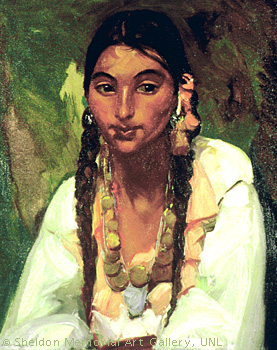
Gypsy Girl in White Robert Henri |
The first group of American artists to advocate a new kind of art and to explore the everyday life of ordinary people in large cities came to be known as “The Eight,” or in reference to their concept, “The Ashcan School.” Led by Robert Henri (1865-1929), they shared a passionate conviction that painting must reflect the artist’s involvement with life as it is lived. Although their paintings represented an abrupt departure from contemporary academicism, eventually the new direction of The Eight would emerge more in content and viewpoint then in style. Robert Henri believed that American life and daily experience was a deserving subject matter for art. Henri’s avocation, once said John Sloan, a protégée of Henri’s, was “making pictures of life” (qtd. in Hunter and Jacobus, American 50). “Life” became the operative word in Henri’s vocabulary, the litany of his teaching. “It referred not so much to the artist’s recording of an object in the external world as to the inward sensation of ‘being alive,’ enhanced by the act and exercise of Painting” (Brown et al. 352). Henri pleaded for the viability of human emotions. “Because we are saturated with life, because we are human,” he remarked in the 1923 edition of The Art Spirit, “our strongest motive is Life, humanity; and the stronger the motive back of the line, the stronger, and more beautiful, the line will be…. It isn’t the subject that counts but what you feel about it” (qtd. in Hunter and Jacobus, American 50). |
In 1891, Henri had met a group of young artist-illustrators who had been working for Edward Davis, the art director of the Philadelphia Press. They were William Glackens, George Luks, Everett Shinn, and John Sloan. Henri imparted to these young men a new cosmopolitan spirit, urging them to travel abroad and to devote themselves to oil painting rather than to illustration. In 1904, he set up a school of his own in New York City’s Lincoln Arcade, in the Latin Quarter district on upper Broadway. Gathered there were all the rebels against the genteel tradition: the Philadelphia artists who had followed Henri to New York, and others, such as George Bellows and Glenn O. Coleman, who were to associate themselves with the New Realism (Arnason 420).
Henri “redirected the [Philadelphia group’s] attention to subjects taken from contemporary city life--rooftops and backyards, Bohemian restaurants, ferryboats, and crowded streets” (Brown et al. 353). Following his example, the group members were innovative primarily in subject matter rather than in formal structure or style, changing in their attitude not toward painting but toward life. Compared to contemporary European artistic developments, their work was not revolutionary; however, the “vulgarity” of their subject matter was enough to provoke sharp criticism for a time, at least, until their offences paled beside the public outrage aroused by the introduction of avant-garde modernism at the Armory Show of 1913. Overnight, the Armory Show made realism seem conservative and dated. Still, The Eight were the first Americans in the century to revive an insurgent mood, to depict urban ugliness, and to venture into the modern mainstream by breaking the hold of the academic past.
The Realist group’s new departures in mood, subject matter, and social attitude, if not in style and technique, soon aroused the open hostility of the official art world. The challenge of Henri, Luks, Sloan, Glackens, and Shinn to contemporary authority met with increasing rejections of their work by the National Academy and the Society of American Artists. Suppression by these institutions, as well as by the small number of private art galleries then showing works in America denied the artists public exposure. When, in 1907, the jury for the National Academy voted to exclude entries by several members of his group; Henri withdrew from the exhibition in protest. With Glackens and Sloan, Henri formulated plans for a counter exhibition that would be the first large independent's show of the new century. (continue)
Ashcan School | George Bellows | Ernest Lawson | Everett Shinn | George Luks | William Glackens | Robert Henri | John Sloan | Maurice Prendergast | Georgia O'Keefe | Charles Sheeler
Armory Show Web Site
Linda M. Larson. All rights reserved.
Revised: 29 Nov 2000 14:30:28 -0500 .